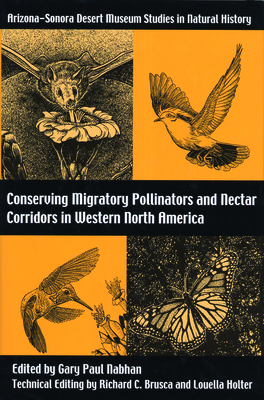

 University of Arizona Press
University of Arizona Press
Conserving Migratory Pollinators and Nectar Corridors in Western North America


Key Metrics
- Gary Paul Nabhan
- University of Arizona Press
- Paperback
- 9780816542420
- 9 X 6 X 0.7 inches
- -
- Science > Environmental Science (see also Chemistry - Environmental)
- English
 Secure Transaction
Secure TransactionBook Description
This book, a unique work of comparative zoogeography and conservation biology, is the first to bring together studies of these important migratory pollinators and of what we must do to conserve them. It considers the similarities and differences among the behavior and habitat requirements of several species of migratory pollinators and seed dispersers in the West--primarily rufous hummingbirds, white-winged doves, lesser long-nosed bats, and monarch butterflies. It examines the population dynamics of these four species in flyways that extend from the Pacific Ocean to the continental backbone of the Sierra Madre Oriental and Rocky Mountains, and it investigates their foraging and roosting behaviors as they journey from the Tropic of Cancer in western Mexico into the deserts, grasslands, and thornscrub of the U.S.-Mexico borderlands. The four pollinators whose journeys are traced here differ dramatically from one another in foraging strategies and stopover fidelities, but all challenge many of the truisms that have emerged regarding the status of migratory species in general. The rufous hummingbird makes the longest known avian migration in relation to body size and is a key to identifying nectar corridors running through northwestern Mexico to the United States. And there is new evidence to challenge the long-supposed separation of eastern and western monarch butterfly populations by the Rocky Mountains as these insects migrate.
Conserving Migratory Pollinators and Nectar Corridors in Western North America demonstrates new efforts to understand migratory species and to determine whether their densities, survival rates, and health are changing in response to changes in the distribution and abundance of nectar plants found within their ranges. Representing collaborative efforts that bridge field ecology and conservation biology in both theory and practice, it is dedicated to safeguarding dynamic interactions among plants and pollinators that are only now being identified.
Author Bio
Gary Nabhan, Ph.D., W.K. Kellogg Chair in Southwest Borderlands Food and Water Security, is an ethnobiologist, agroecologist, conservation biologist and cultural geographer trained at the University of Arizona and Prescott College.
He is author or editor of 26 books translated into 6 languages, a number of which have won awards. In addition to his research, teaching and community service on sustainable food systems, Nabhan farms during the summer in Patagonia, Arizona. Political Ecology of Food, Conservation Ranching and Ecosystem Services, Traditional Ecological Knowledge, Sustainable Food Systems, and Science Writing.
Current Projects: Tumamoc Hill phenology change; Sonoran Desert oasis initiative (with Susie and Paul Fish); Sabores Sin Fronteras Foodways Alliance; Stitching the West Back Together working landscapes initiative (with Tom Sheridan and Susan Charnley); biodiversity of desert oases (with Rafael Routson and Amadeo Rea); Renewing America's Food Traditions agrobiodiversity inventory (with Collaborative, American Livestock Breeds Conservancy and Western Folklife Center); climate change adaptation and agrobiodiversity (with the University of Arizona Institute for the Environment).
Source: The University of Arizona
Videos












Community reviews
Write a ReviewNo Community reviews